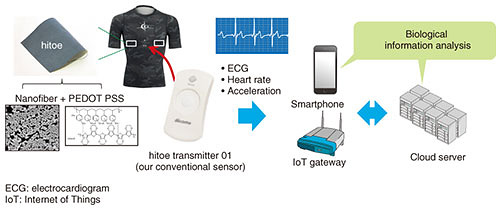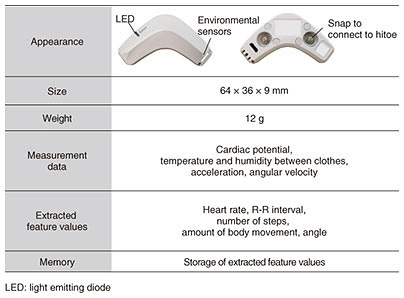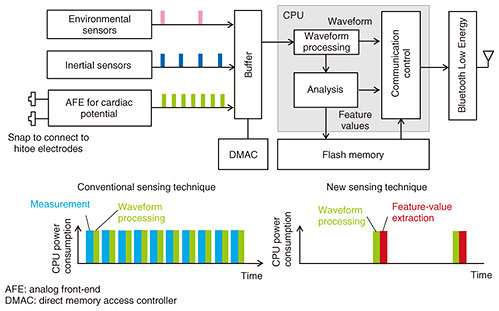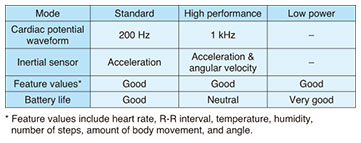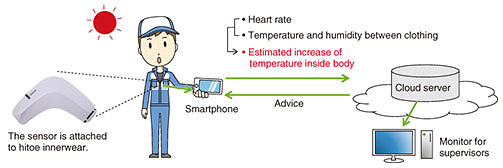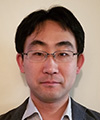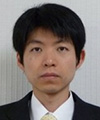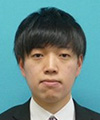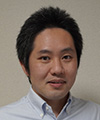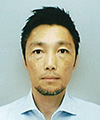 |
|||||||||||||||
|
|
|||||||||||||||
|
Regular Articles Vol. 18, No. 10, pp. 46–51, Oct. 2020. https://doi.org/10.53829/ntr202010ra2 Wearable Biological/environmental Sensor and Its Application for Smart Healthcare ServicesAbstractSmart healthcare services using wearable biological sensors are gaining interest regarding healthy living and safe working conditions. NTT and Toray Industries, Inc. have developed a smart textile called hitoeTM, which enables the measurement of biological information, such as heart rate and cardiac potential, by just wearing a shirt with hitoe electrodes. This article introduces a new sensor, which is used in combination with hitoe, that is small, has low power consumption, and enables multi-sensing of biological and environmental information. Its application for physical condition management of workers in hot environments is also introduced. Keywords: wearable device, biological and environmental sensor, physical condition management 1. IntroductionWearable devices with biological sensors have been used recently for monitoring lifestyle, such as exercise and sleep, to provide advice for living a healthy life. These devices are also useful to offer physical condition management services for workers, especially in summer, due to global warming. For wearable devices to sustainably contribute to living a healthy life, they need to be more natural and intuitive and blend into daily life. NTT has jointly developed the conductive textile hitoeTM through collaboration with Toray Industries, Inc. in the form of shirt-type clothing for daily biological measurements [1]. In this article, we introduce a new wearable sensor, which is used in combination with hitoe, that is small, has low power consumption, and enables multi-sensing of biological and environmental information. In Section 2, we briefly introduce wearable sensor involving hitoe and its challenges regarding natural sensing. In Section 3, we describe the features and specifications of the new sensor. In Section 4, we explain the multi-sensing technique we developed to reduce power consumption. Finally, in Section 5, we introduce an application of the sensor for physical condition management of workers in hot environments. 2. Wearable sensing technology using hitoeThe textile hitoe is a functional nanofiber material coated with the conductive polymer PEDOT-PSS*1. It has flexibility and breathability, and its hydrophilicity allows stable contact to the skin. As a result, biological information, such as heart rate and cardiac potential, can be measured with high sensitivity [2]. For daily monitoring of biological information, hitoe electrodes are embedded in a garment, such as the innerwear shown in Fig. 1. Our conventional sensor that includes analog front-end circuits, an analog-digital converter, accelerometer, central processing unit (CPU), and radio-frequency circuits for Bluetooth Low Energy communication is attached to the innerwear and connected to the hitoe electrodes via snaps on the garment. The measured data are sent to the smartphone for visualization then sent to the cloud servers for data storage and additional signal processing. This hitoe wearable sensing technology was applied for various applications such as sports, worker safety, and rehabilitation [3, 4].
To make wearable sensing technology more natural for our daily lives, miniaturization and long battery life of the sensor are required to reduce the interference with the user’s movement and the frequency of battery charging. The problem that a smartphone must always be carried to collect data constantly also needs to be solved. For smart healthcare, such as physical condition management of workers in hot environments, not only biological information but also environmental information is important to evaluate the thermal stress on individuals [5]. Since conventional environmental sensors, such as wet bulb globe temperature (WBGT) heat stress monitors, are too large for natural sensing, wearable devices capable of multi-sensing of biological and environmental information are effective for such application.
3. New wearable biological/environmental sensorTo address the above issues, we developed the wearable sensor shown in Fig. 2 that is small (12 g), has low power consumption, and enables multi-sensing of biological and environmental information. The sensor can be attached to hitoe innerwear to measure biological information such as heart rate and cardiac potential. The sensor can also measure the environment between clothing. When outerwear is worn over the hitoe innerwear, the sensor monitors the temperature and humidity of the space between the two garments. These data are useful to assess a wearer’s heat stress and comfortability. Furthermore, acceleration and angular velocity can be measured to monitor body movements. From these measurement data, the sensor can extract various feature values such as heart rate, R-R interval*2, number of steps, amount of body movement, and angle. These measurement data and the extracted feature values are transmitted to the smartphone or Internet-of-Things gateway via Bluetooth Low Energy. The extracted feature values are stored in the sensor’s internal memory so that the data can be collected if the wearer does not have a smartphone during measurement. Due to the ergonomically designed housing, the sensor fits in a gap between the chest and abdomen, allowing it to be worn comfortably without obstructing movement such as bending and lying down.
4. Multi-sensing technique for low power operationWhen various data are continuously measured, analyzed, and transmitted, the CPU load and power consumption increase. As a result, frequent charging is required due to shortened operation time or a large battery is required to maintain operation time. To overcome these problems, our sensor uses a multi-sensing technique we developed to reduce power consumption. Figure 3 shows the circuit configuration and flow of this technique. By effectively using a direct memory access controller, various data are measured and accumulated in a buffer while the CPU is sleeping. After a certain amount of data has been accumulated, the CPU is activated only for a short time to perform waveform processing and feature-value extraction.
Our biological/environmental sensor has the three operating modes shown in Table 1 to meet different requirements, e.g., the necessity of waveform and angular velocity, and battery life depending on the application. In standard mode, the transmission of the cardiac potential waveform at a sampling rate of 200 Hz, acceleration waveform, and extracted feature values is enabled. In high performance mode, the sampling rate of the cardiac potential waveform is improved to 1 kHz, and the angular velocity measurement is enabled. In low power mode, the battery life is extended by stopping the waveform transmission.
By reducing the CPU load, this sensor in standard mode operates at about 30% the power consumption of our conventional sensor but with additional measurement and analysis functions. In low power mode, the power consumption is further reduced to about 15% that of the conventional sensor. As a result, the new sensor is about half the size of the conventional one by using a smaller battery, and more than 100 hours of operation is possible in low power mode. 5. Application to physical condition management of workers in hot environmentsAs an application of the wearable biological/environmental sensor, we are developing a physical condition management system for workers in hot environments, as shown in Fig. 4.
While conventional systems using WBGT sensors are effective in providing an indication of heat stress in certain areas, the environment may change significantly depending on the location such as indoors or outdoors or in sunlight or shade. The clothing and activities also affect the heat stress on individuals. In a prototype of our system, our wearable biological/environment sensor is attached to hitoe innerwear to measure heart rate and the temperature and humidity between the innerwear and outerwear. To evaluate the heat stress on an individual, the heat exchange between the environment and human body is calculated from the measured data, and the heat stored in the body is estimated. If the temperature is expected to rise, workers and supervisors receive advice such as drink more water and take breaks. We are collaborating with universities including Nagoya Institute of Technology to improve and verify the accuracy of the heat estimation through experiments in an artificial weather control room. The field trials at the construction sites of NTT Group companies are scheduled this summer to evaluate the effectiveness of the system. We will work to create smart healthcare services that use wearable biological/environmental sensors through these trials. References
|
|||||||||||||||









